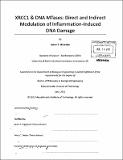XRCC1 & DNA MTases : direct and indirect modulation of inflammation-induced DNA damage
Author(s)
Mutamba, James T. (James Tendai)
DownloadFull printable version (28.25Mb)
Alternative title
Direct and indirect modulation of inflammation-induced DNA damage
Other Contributors
Massachusetts Institute of Technology. Dept. of Biological Engineering.
Advisor
Bevin P. Engelward and Peter C. Dedon.
Terms of use
Metadata
Show full item recordAbstract
Cancer causes 13% of all deaths worldwide. Inflammation-mediated cancer accounts for ~15% of all malignancies, strongly necessitating investigation of the molecular interactions at play. Inflammatory reactive oxygen and nitrogen species (RONs), including peroxynitrite and nitric oxide (NO'), may potentiate malignancy. We hypothesize that the base excision repair (BER) pathway modulates susceptibility to malignancy, by modulating the BER-intermediate levels, large scale genomic rearrangements and toxicity following exposure to RONs. We further hypothesize that DNA methyltransferases are responsible for the memory of genotoxic insult, and the epigenetic propagation of genomic instability, following exposure to genotoxins. Here, we exploited cell lines engineered to carry deficiencies in BER to study repair of DNA damage induced by RONs. Toxicity and BER-intermediate levels were evaluated in XRCC1 proficient and deficient cells, following exposure to the peroxynitrite donor, SIN-1 and to NO*. Using the alkaline comet assay, we find that while XRCC1 proficient and deficient CHO cells incur equivalent levels of SIN-1 induced BER-intermediates, the XRCC1 null cells are more sensitive to killing by SIN-1, as assessed by clonogenic survival. Furthermore, using bioreactors to expose CHO cells to NO', we found that the BER-intermediate levels measured in XRCC1 null cells were lower than in WI cells. We found that while XRCC1 can facilitate AAG-mediated excision of the inflammation-associated base lesions ethenoadenine and hypoxanthine, in vitro; XRCC1 deficient human cells were no more susceptible to NO' than WT cells. However, in live glioblastoma cells, XRCC1 is acting predominantly downstream of AAG glycosylase. This work is some of the first to assess the functional role of XRCC1, in response to RONs and suggests complexities in the role of XRCC1. We also demonstrate that the underlying basis for the memory of a genotoxic insult and the subsequent propagation of genomic instability is dependent on the DNA methyltransferases, Dnmtl and Dnmt3a. We found that a single exposure led to long-term genome destabilizing effects that spread from cell to cell, and therefore provided a molecular mechanism for these persistent bystander effects. Collectively, our findings impact current understanding of cancer risk and suggest mechanisms for suppressing genomic instability, following exposure to inflammatory genotoxins.
Description
Thesis (Ph. D.)--Massachusetts Institute of Technology, Dept. of Biological Engineering, 2011. Cataloged from PDF version of thesis. Includes bibliographical references (p. 164-183).
Date issued
2011Department
Massachusetts Institute of Technology. Department of Biological EngineeringPublisher
Massachusetts Institute of Technology
Keywords
Biological Engineering.